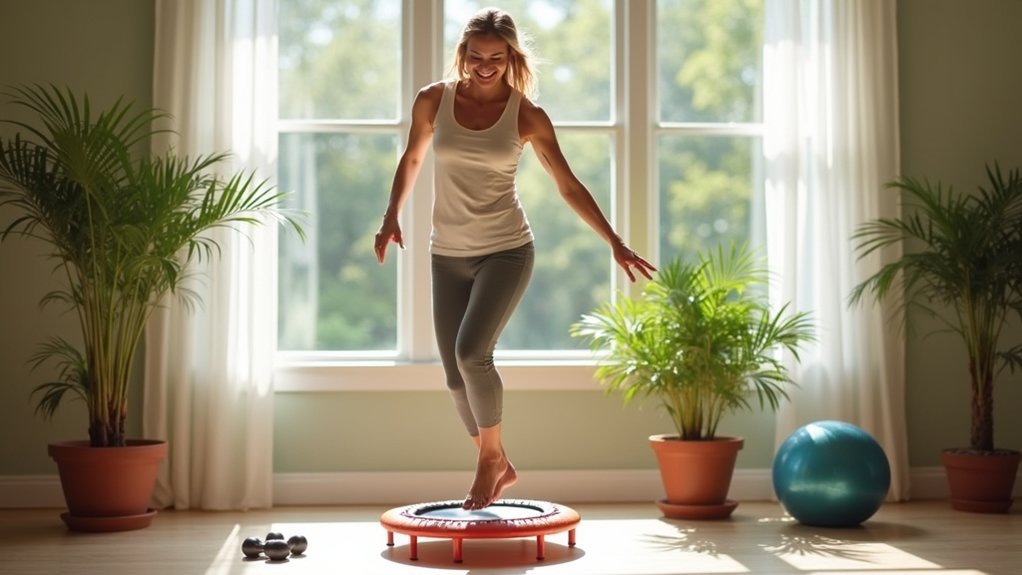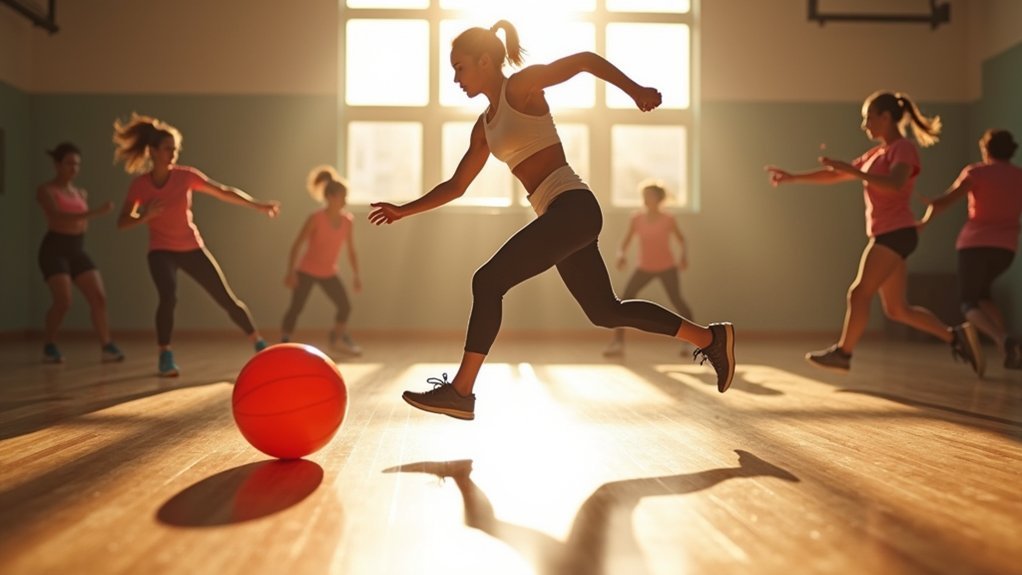The 3 best rebounding workouts for osteoporosis prevention are: 1) Gentle bounce progressions with milkmaid arm movements to safely stimulate bone growth, 2) Core-engaging sequences using light hand weights (1-2 pounds) to increase resistance and bone loading, and 3) Dynamic directional movements that create mechanical stress on multiple bone planes. You’ll get maximum benefits by practicing these for 2-3 minutes each, several times weekly. Discover how these targeted exercises can transform your bone health journey.
Gentle Bounce Progression for Beginners

When you’re new to rebounding, starting with gentle, controlled movements guarantees both safety and effectiveness for bone health.
Position your feet hip-width apart on your JumpSport 350 Pro trampoline and begin with basic gentle bouncing while engaging your core strength. This simple motion stimulates bone density without risking injury.
Once comfortable, introduce the milkmaid arm movement while maintaining your core engagement. This helps improve coordination while providing additional bone stimulation.
As your confidence grows, incorporate gentle twisting movements and modified jumping jacks to challenge your balance and strengthen your lower body.
Consistent practice of these beginner-friendly exercises will gradually build bone strength.
Core-Engaging Rebound Sequences With Hand Weights
Now that you’ve mastered the gentle bouncing basics, adding hand weights will supercharge your bone-building routine. The JumpSport 350 Pro trampoline provides the perfect low-impact surface to strengthen your core engagement while protecting your joints.
Hold 1-2 pound weights during your rebound sessions to increase resistance and stimulate greater bone density. Incorporate twisting movements and directional jumping jacks to target multiple muscle groups simultaneously.
| Exercise | Benefits | Duration |
|---|---|---|
| Weighted Bounce Twists | Strengthens pelvic floor | 2 min |
| Diagonal Reaches | Enhances coordination | 3 min |
| Weighted Knee Lifts | Builds core stability | 2 min |
| Side-to-Side Jumps | Promotes healthy bones | 3 min |
These weighted sequences improve balance and posture while reducing fall risks—critical for osteoporosis prevention. Your core and pelvic floor will thank you!
Dynamic Directional Movements for Advanced Bone Stimulation

As your rebounding skills develop, incorporating dynamic directional movements will maximize your bone-building potential.
Try adding twisting motions and jumping jacks on your JumpSport 350 Pro to engage multiple muscle groups simultaneously while stimulating bone density.
Challenge yourself with directional variations—bounce front to back and side to side to enhance proprioception, essential for preventing falls and fractures.
These movements create mechanical loading on different bone planes, triggering more effective bone remodeling.
Always engage your core and pelvic floor during these exercises to maintain proper skeletal alignment.
The low-impact nature of trampoline rebounding protects your joints while still delivering the weight-bearing benefits your bones need.
Frequently Asked Questions
Should You Use a Rebounder if You Have Osteoporosis?
You can use a rebounder with osteoporosis, as it’s low-impact and helps build bone density. Always consult your healthcare provider first and start slowly without weights to guarantee safety.
What Is the Best Exercise to Reverse Osteoporosis?
To reverse osteoporosis, you’ll benefit most from weight-bearing exercises like walking, stair climbing, and resistance training. These activities stimulate bone formation, increase density, and strengthen muscles that support your skeleton. Don’t forget proper nutrition too.
What Is the Downside of Rebounding?
Rebounding’s downsides include potential injury risks, especially if you have osteoporosis. You’ll face fall hazards with poor balance, possible joint strain from overexertion, and increased injury risk when using weights without proper form.
How Many Minutes a Day Should You Rebound?
You should rebound for 10-20 minutes daily for ideal benefits. If you’re a beginner, start with 5-10 minute sessions and gradually increase. Aim for 3-5 sessions weekly, totaling about 150 minutes of moderate exercise.
In Summary
You’ve now got three effective rebounding routines to strengthen your bones and fight osteoporosis. Start with the gentle progression if you’re new, advance to the weighted sequences as you build confidence, and challenge yourself with directional movements when you’re ready. Even a few minutes daily will stimulate bone growth. Remember, it’s never too late to bounce your way to stronger bones and better balance.




Leave a Reply